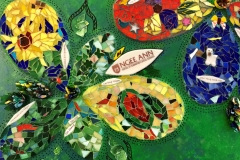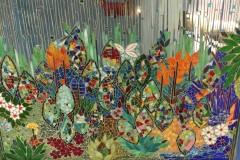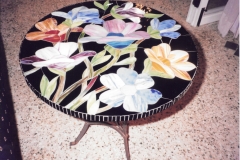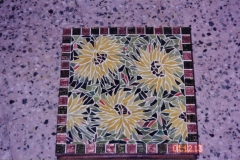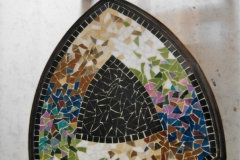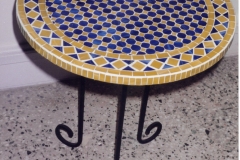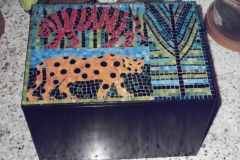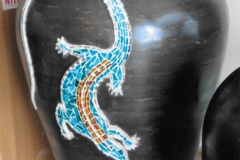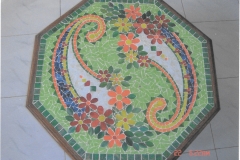Please give us an introduction on yourself.
Like a lot of women, I play very many roles, daughter, daughter-in-law, wife and mother. I think it’s my free spirited nature and artistic soul that has made me enjoy my journey so far. I’m a glass artist with an eclectic sense of art and design. I have a passion for all types of art and craft. I’m nosy; I’m interested in people and what they do!
How did you stumble onto mosaics and how long ago was that?
As a kid I would visit Rock Garden in Chandigarh often. I would collect broken tiles, mirror and bangles and stick them on my cupboard, cut magazine papers and make a collage.
Assembling bits and pieces together has been a life long effort for me.
I’ve dabbled in block printing of sarees, painting dupattas, pottery, painting, designing carpets, bookcovers and making stationery. I use the word dabbled, perhaps wrongly… for very many years these pursuits were my source of income. But once I started working with glass I stuck with it. It’s a difficult medium and I love the challenge of it.
I have formally worked with glass for over 20 years. Initially I used to sell my paintings to make the money to buy glass and tools.
I’ve run a glass studio in Chennai for very many years. I’ve shifted base to Singapore and run a studio there today. I visit Chennai twice a year and teach mosaics there.
What is your preferred mosaic media? Do tell us about any challenges you face in its sourcing or stocking.
I am a glass artist. In my mosaics, the main materials used are always glass. I like to incorporate the unusual and unexpected into my work.
When I started working with glass many years ago, I had to rely on books…. No classes, no internet with its fountain of information. And the books were expensive!
My supplies were dependant on a visit abroad. My dear husband used to lug around sheets of coloured glass and baby diapers from all over the world!
I strongly believe that lack of resources make one more resourceful.. a lot of my work today, like using broken glass bottles, broken mirrors etc is a direct result of not being able to source readily available materials.
With today’s flattening of the world, information, guidance and supplies are easily available.
Mosaicist to a large extent are hoarders. Bit and pieces are collected over time with an idea that it might be useful in some design. This can sometimes become overwhelming. Regular sorting and pruning of supplies is essential to keep both mind and space clutter free.
What all have you made in mosaics?
I’ve mosaicked a whole bunch of things including 2’ square planters, dining tables, smaller tables, wall art, jewelry etc
What are you currently working on?
I love what I’m working on currently. I’ve been teaching seniors at an activity centre in Singapore the joys of mosaic. The theme for the Project is ‘JOY’
Over a period of 7 sessions, the seniors have played with glass shards and tiles, drawn out and coloured what brings them joy and then assembled the mosaic on net. Initially they were a bit hesitant exploring this new medium but over time their eagerness, ideas and enthusiasm grew. Each one of the 23 participants has made a petal shape and a few leaves. I’ve assembled them into a garden of flowers. Each petal showcases what the seniors like. I fused little birds, flowers, butterflies, a dog, fish and a house with a red roof. These designs were made on the basis of their drawings. I’ve fused their names too!
This has been a hugely enriching experience for me and I’m grateful to be part of it.
Where do you find inspiration for your compositions? What kind of themes interest you?
As I mentioned earlier…I’m nosy. I pay attention to sights, sounds, patterns, colour … basically I pay attention to the world around me! I think in the abstract, so my work reflects that. I almost never make true to life subjects, its always my version of what I see/perceive.
What is the typical size of your mosaic pieces? How long does it take you on average to complete a mosaic?
The size of my art work depends on whether it’s a commission or something for fun. I advice my clients about suitability of size, theme, colours etc but if it’s a commissioned piece ultimately the final decision lies with the clients. Over time, I’ve developed a clientele that likes to buy my pieces off the shelf. They finally trust my judgement!
Time taken depends on how much time I get. Some projects have a tight deadline, others are more relaxed. I personally like to start a project and finish it as fast as I can.
Do you mosaic every day and for how many hours? Do describe your work area.
Today, I run a glass studio in Singapore. I work and teach there. I work from 10 am to 6 pm mostly 5 days a week and often teach on weekends. My work schedule depends on what I have on my plate.
It sounds like I have no life at all but for me it’s actually not work!
I have people dropping by the studio regularly and enjoy the interaction and different points of view and style of working of my students.
I have designated areas in my studio for mosaic, stained glass and glass fusing-kilns and try to keep things organized, but of course that’s easier said than done!
What challenges have you encountered in mosaic-making?
I think my personal challenges have always been in sourcing something standard that just works… Like, one just goes to X shop and gets Y material and moves on to the fun part of design etc.
I’ve moved around a bit and have had to scout around for certain materials wherever I go… cement, grout etc. These are not commonly used materials and the average person just doesn’t know enough to help.
Many individuals even without much exposure to art-creation or training, seem to gravitate towards mosaic-making to find mental peace. Do you feel that way? Why is that?
Mosaic is therapeutic. There is something about placing one fragment after another to make a whole, that is engrossing and very satisfying. The only thought is what piece comes next, the colour, shape or size. The act of making mosaic clears the head of all the incessant chatter… a sure-fire path to mental peace.
What is your advice to a new mosaic learner based in India?
Making mosaics is picking up rapidly in India and three cheers to that.
There is so much information out there, but one does not have to follow what a hundred other mosaicists have done. There is no point waiting for all the materials that we read about to magically materialise. Take the effort to explore new possibilities.
Experiment.. Find a new way. This is also in terms of design and style. While I believe, there is nothing really original in this world, it’s nice to put one’s own spin into things. Always remember to enjoy the journey, not only the final finished artwork.
There will always be a new tool that supposedly cuts down work to half, or some shiny new material but it’s good to remember that actually most of that does not matter. What matters is what the mosaicist makes out of what is available. Their passion for their work.
Nek Chand’s Rock Garden, in Chandigarh and Isaiah Zagar’s Magic Gardens in Philadelphia are proof of that.
What is your view of the Facebook group Mosaic India and its website? What kind of content would you like to see on it in future?
I like this group and enjoy being part of it. I’m happy to pitch in and clear any doubts that I can. However I think it would be nice if anybody posting pictures of finished work explains a bit of what they have used and how they have made it.
I think this page is not a page to show off one’s work; most people have their own FB page for that. And there are enough pages to drool over mosaics and other inspiring artwork.
It’s for sharing knowledge.
Post a Mosaic related query and people who can and are willing to help should answer, without any prompting from the admin.
Post a photo of your work only if you also describe the process and materials used a little bit, again without any prompting from the admin.
A lot of us, including me, earn a living making mosaics. It’s not fair to expect us to give out all our ways of working, taking workshops, pricing and finding a market. Which is why some questions do not get answered. That’s totally acceptable to me. However if I post a picture of my work, I should be prepared to let people know how it is made.
Do you teach mosaic-making or will do so in the near future? If yes, please mention your city.
I teach Mosaics regularly. I have a couple of types of workshops that I conduct in Singapore, including for schools and other groups.
The age group is from 5+ to 80+ years.
I visit Chennai twice a year and teach Mosaics there. In a few days time I’m going to be teaching an intensive Mosaic workshop in Bangalore.
What do you aspire to do as a mosaic-maker over the next 5 years?
I want to be more involved with community projects and teaching; spreading the joys of making mosaics.
Please mention your preferred way for people to reach you.
Email: anjalidesign9@gmail.com
Is there a gallery link or website of your mosaics that you would like to share with others?
www.anjalidesign.com
FB Anjali Design https://www.facebook.com/anjalidesignglass/
Please share some of your favourite mosaics from your creations. Is there any story about them that you would like to share?
My current two favourite mosaics are community projects. One at the Science Center in Singapore, where I was a Maker in Residence early this year. Visitors to the center irrespective of age made a small mosaic. I assembled all the pieces to make one big mural. It was great fun for me to show people how to cut glass and fit pieces together to make a whole.
The second is the Mosaic made at the senior activity centre, which I mentioned earlier.
While conducting these projects I try and make small personal charms for the participants so they can identify their handiwork in the midst of hundreds of other contributions.
The questions were compiled by Jyoti Bhargava and the interview was carried out by email.


